Janome Horizon Memory Craft 8200QCP Special Edition Instruction Manual

Instruction Book

IMPORTANT SAFETY INSTRUCTIONS
When using an electrical appliance, basic safety precautions should always be followed, including the following:
This sewing machine is designed and manufactured for household use only. Read all instructions before using this sewing machine. DANGER— To reduce the risk of electric shock:
1.An appliance should never be left unattended when plugged in. Always unplug this sewing machine from the electric outlet immediately after using and before cleaning.
WARNING—To reduce the risk of burns, fire, electric shock, or injury to persons:
1.Do not allow to be used as a toy. Close attention is necessary when this sewing machine is used by or near children.
2.Use this appliance only for its intended use as described in this owner’s manual.
Use only attachments recommended by the manufacturer as contained in this owner’s manual.
3.Never operate this sewing machine if it has a damaged cord or plug, if it is not working properly, if it has been dropped or damaged, or dropped into water.
Return this sewing machine to the nearest authorized dealer or service center for examination, repair, electrical or mechanical adjustment.
4.Never operate the appliance with any air opening blocked. Keep ventilation openings of this sewing machine and foot controller free from accumulation of lint, dust and loose cloth.
5.Never drop or insert any object into any opening.
6.Do not use outdoors.
7.Do not operate where aerosol (spray) products are being used or where oxygen is being administered.
8.To disconnect, turn all controls to the off (“O”) position, then remove plug from outlet.
9.Do not unplug by pulling on cord. To unplug, grasp the plug, not the cord.
10.Keep fingers away from all moving parts. Special care is required around the sewing machine needle and/or cutting blade.
11.Always use the proper needle plate. The wrong plate can cause the needle to break.
12.Do not use bent needles.
13.Do not pull or push fabric while stitching. It may deflect the needle causing it to break.
14.Switch this sewing machine off (“O”) when making any adjustment in the needle area, such as threading the needle, changing the needle, threading the bobbin or changing the presser foot, and the like.
15.Always unplug this sewing machine from the electrical outlet when removing covers, lubricating, or when making any other adjustments mentioned in this owner’s manual.
SAVE THESE INSTRUCTIONS
For Europe only:
This appliance can be used by children aged from 8 years and above and persons with reduced physical, sensory or mental capabilities or lack of experience and knowledge if they have been given supervision or instruction concerning use of the appliance in a safe way and understand the hazards involved. Children shall not play with the appliance. Cleaning and user maintenance shall not be made by children without supervision.
For outside Europe (except U.S.A and Canada):
This appliance is not intended for use by persons (including children) with reduced physical, sensory or mental capabilities, or lack of experience and knowledge, unless they have been given supervision or instruction concerning use of the appliance by a person responsible for their safety.
Children should be supervised to ensure that they do not play with the appliance.
 Please note that on disposal, this product must be safely recycled in accordance with relevant
Please note that on disposal, this product must be safely recycled in accordance with relevant 

 National legislation relating to electrical/electronic products. If in doubt please contact your
National legislation relating to electrical/electronic products. If in doubt please contact your  retailer for guidance. (European Union only)
retailer for guidance. (European Union only)
1
TABLE OF CONTENTS
Names of PaRTS |
|
Names of Parts............................................................... |
3 |
Standard Accessories..................................................... |
4 |
Accessories Storage....................................................... |
5 |
Extension Table.............................................................. |
5 |
GeTTING ReADY to SeW |
|
Connecting the Power Supply......................................... |
6 |
Machine Operating Buttons............................................ |
7 |
Controlling Sewing Speed.............................................. |
8 |
Foot control..................................................................... |
8 |
Function Keys................................................................. |
9 |
Raising and Lowering the Presser Foot........................ |
10 |
Knee Lifter..................................................................... |
10 |
Adjusting the Foot Pressure........................................... |
11 |
Dropping the Feed Dog.................................................. |
11 |
Balancing Thread Tension............................................ |
12 |
Lockout Key.................................................................. |
13 |
Changing the Presser Foot........................................... |
13 |
Removing and Attaching the Foot Holder..................... |
14 |
Dual Feed Foot......................................................... |
14-15 |
Replacing the Needle Plate.......................................... |
16 |
Changing Needles........................................................ |
17 |
Fabric and Needle Chart............................................... |
17 |
Winding the Bobbin.................................................. |
18-20 |
Threading the Machine................................................. |
21 |
Built-in Needle Threader............................................... |
22 |
Drawing up the Bobbin Thread..................................... |
23 |
Selecting the Patterns................................................... |
24 |
Customizing Machine Settings................................. |
25-27 |
BASIC SEWING |
|
Straight Stitch............................................................... |
28 |
Securing Seams............................................................ |
28 |
Sewing from the Edge of Thick Fabric......................... |
28 |
Changing Sewing Direction........................................... |
28 |
Cutting Threads............................................................ |
29 |
Needle Plate Guides..................................................... |
29 |
Cornering Guide............................................................ |
29 |
Adjusting the Needle Drop Position.............................. |
30 |
Adjusting the Stitch Length........................................... |
30 |
Sewing with the Dual Feed Device............................... |
31 |
Dual Feed Balancing Dial............................................. |
31 |
Straight Stitch Needle Plate.......................................... |
32 |
Lock-a-Matic Stitch....................................................... |
32 |
Locking Stitch............................................................... |
32 |
Straight Stitch with Left Needle Position....................... |
33 |
Triple Stretch Stitch....................................................... |
33 |
Knit Stitch...................................................................... |
33 |
Zipper Sewing.......................................................... |
34-36 |
Rolled Hem................................................................... |
37 |
Gathering...................................................................... |
38 |
Pintucking..................................................................... |
38 |
Zigzag Stitch................................................................. |
39 |
Multiple Zigzag Stitch (Tricot stitch).............................. |
40 |
Overcasting Stitch......................................................... |
40 |
Knit Stitch...................................................................... |
41 |
Double Overcasting Stitch............................................ |
41 |
Blind Hemming......................................................... |
42-43 |
Shell Tuck...................................................................... |
44 |
Buttonholes................................................................... |
44 |
Square Buttonhole................................................... |
45-48 |
Using the Stabilizer Plate.............................................. |
49 |
Round End and Fine Fabric Buttonholes...................... |
50 |
Keyhole Buttonhole....................................................... |
50 |
Stretch Buttonholes....................................................... |
50 |
Corded Buttonhole........................................................ |
51 |
Welted Buttonhole.................................................... |
52-53 |
Button Sewing............................................................... |
54 |
Darning..................................................................... |
55-56 |
Tacking.......................................................................... |
57 |
Eyelet............................................................................ |
58 |
DECORATIVE STITCHING |
|
Applique........................................................................ |
59 |
Fringing......................................................................... |
60 |
Drawn Work............................................................. |
60-61 |
Smocking...................................................................... |
61 |
Fagoting........................................................................ |
62 |
Scallop.......................................................................... |
62 |
French Knots................................................................. |
62 |
Patchwork Piecing........................................................ |
63 |
Patchwork..................................................................... |
63 |
Quilting.......................................................................... |
64 |
Stippling........................................................................ |
65 |
Clasp Stitches............................................................... |
65 |
Free Motion Quilting (1)............................................ |
65-66 |
Free Motion Quilting (2)................................................ |
66 |
Hand-look Quilt Stitches............................................... |
67 |
Satin Stitches................................................................ |
67 |
Elongation ratio............................................................. |
67 |
Twin Needle Sewing................................................ |
68-69 |
PrOGRAMMING a PaTTERN CoMBINATION |
|
Pattern Combination..................................................... |
70 |
Programming Auto-lock Stitch...................................... |
71 |
Programming Automatic Thread Cutting....................... |
72 |
Pattern Combination with a Mirror Image..................... |
73 |
Resuming a Pattern from the Beginning....................... |
74 |
Resuming a Pattern Combination from the Beginning.. 74 |
|
Bridge Stitches......................................................... |
75-76 |
Monogramming......................................................... |
77-78 |
Editing a Pattern Combination...................................... |
79 |
Deleting and Inserting a Pattern................................... |
80 |
Duplicating a Pattern..................................................... |
80 |
Uniform Stitch Adjustment............................................ |
81 |
Unified Needle Drop Position........................................ |
81 |
Individual Stitch Adjustment.......................................... |
82 |
Correcting Distorted Stitch Patterns............................. |
83 |
CARE AND MAINTENANCE |
|
Cleaning the Hook Area................................................ |
84 |
Cleaning the Inside of the Thread Guide...................... |
85 |
Problems and Warning Signals................................ |
86-87 |
Troubleshooting............................................................ |
88 |
2

r |
|
|
|
t |
e |
|
|
|
|
|
|
|
|
y |
w |
|
|
|
|
q |
|
|
|
|
!1!0 |
o |
|
i |
u |
|
|
|
|
@5 |
|
|
|
|
@4 |
!2 |
|
|
|
|
!3 |
|
|
|
|
!4 |
|
|
|
@3 |
|
|
|
|
@2 |
|
|
|
|
@1 |
|
|
|
|
!9@0 |
|
|
|
!8 |
|
!5 |
|
!7 |
|
|
!6 |
|
|
||
|
|
|
@6 |
|
#2 |
|
|
@7 |
|
|
|
|
|
|
#3 |
|
|
|
@8 |
|
|
|
|
|
|
|
|
|
@9 |
#4 |
|
|
|
|
|
|
|
|
#0 |
|
|
|
|
#1 |
#5 |
|
|
|
|
|
|
|
|
#6 |
#7 |
|
|
|
|
#8 |
|
|
|
|
|
|
|
|
$0 |
#9 |
|
|
|
$1 |
|
|
|
$2 |
|
|
|
|
|
3 |
Names of PaRTS
Names of Parts
q Thread take-up lever w Foot pressure dial e Reference chart
r Top cover
t Foot storage compartment y Bobbin thread cutter
u Bobbin winder spindle i Hole for extra spool pin o Spool holder (large)
!0Spool pin !1Thread tension dial !2Face cover !3Thread cutter
!4Extension table (accessory storage) !5Needle plate release lever !6Start/stop button
!7Reverse button !8Auto-lock button !9Needle up/down button @0Thread cutter button @1Speed control slider @2Feed balancing dial
@3Knee lifter socket @4Function keys @5LCD screen @6Needle clamp screw @7Needle
@8Zigzag foot A @9Needle plate
#0Hook cover release button #1Hook cover plate #2Buttonhole lever #3Needle threader
#4Foot holder #5Carrying handle #6Presser foot lifter #7Handwheel
#8Dual feed balancing dial #9Drop feed lever $0Power switch
$1Foot control jack $2Machine socket
NOTE:
To carry the sewing machine, hold the carrying handle with your hand, and support the sewing machine with the other hand.
NOTE:
Sewing machine design and specifications are subject to change without prior notice.

q |
w |
e |
r |
t |
y |
u |
i |
o |
|
|
!0 |
!4 |
!5 |
|
|
!1 |
||
|
|
|
|
|
||
|
|
|
|
!2 |
!3 |
|
|
|
|
|
|
|
|
|
!6 |
!8 |
|
|
|
|
|
|
|
|
@0 |
|
|
|
!7 |
!9 |
|
|
|
|
|
@2 |
|
|
|
|
|
@1 |
|
|
@4 |
@5 |
|
@6 |
|
@3 |
|
|
|
|
|
@7 |
@8 |
|
@9 |
|
|
#0 |
|
|
|
|
|||
#2 #3
#1
 #5 #6 #4
#5 #6 #4
#7
Standard Accessories
q Zigzag foot A (set on the machine) w Rolled hem foot D
e Zipper foot E
r Satin stitch foot F
t Open-toe satin stitch foot F2 y Blind hemming foot G
u Overcast foot M i 1/4˝ seam foot O o Darning foot PD-H
!0Convertible free motion quilting foot QB-S !1Close-toe foot
!2Open-toe foot !3Clear view foot
!4Automatic buttonhole foot R !5Buttonhole stabilizer plate !6Dual feed foot holder !7Dual feed foot AD !8Button sewing foot T !9Quilting guide bar
@0Bobbin (5 pcs.) (1 set on the machine) @1Spool holder (large, set on the machine) @2Spool holder (small)
@3Spool holder (special)
@4Spool supporter @5Felt cusion @6Extra spool pin @7Needle set @8Screwdriver @9Lint brush
#0Seam ripper (Buttonhole opener) #1Knee lifter
#2Straight stitch needle plate #3Touch panel stylus #4Power cable
#5Foot control #6Instructional video DVD #7Instruction book
4

w |
q |
i |
|
||
e |
|
o |
|
|
|
|
r |
|
t |
|
!0 |
|
|
|
|
y |
|
u
Accessories Storage
The accessories can be conveniently stored in the foot storage compartment under the top cover and in the extension table.
Under top cover: q Zigzag foot A w Overcast foot M e Zipper foot E
r Satin stitch foot F
t Blind hemming foot G y Foot holder
u Touch panel stylus i Clear view foot
o Open-toe foot !0Close-toe foot
q |
w
e

 r t
r t
w
q
w
In extension table:
q Automatic buttonhole foot R w Buttonhole stabilizer plate e Straight stitch needle plate r Bobbin
t Presser foot
Other accessories can be also stored in the compartment.
Extension Table
The extension table provides an extended sewing area and can be removed for free-arm sewing.
q Extension table w Free-arm
To detach:
Draw the table out to the left.
To attach:
Slide the table on the base and push the table to the right.
Free-arm sewing
Free-arm sewing is used for stitching sleeves, waistbands, pant legs or any other tubular garments. It is also useful for darning socks or mending knees or elbows.
w Free-arm
5
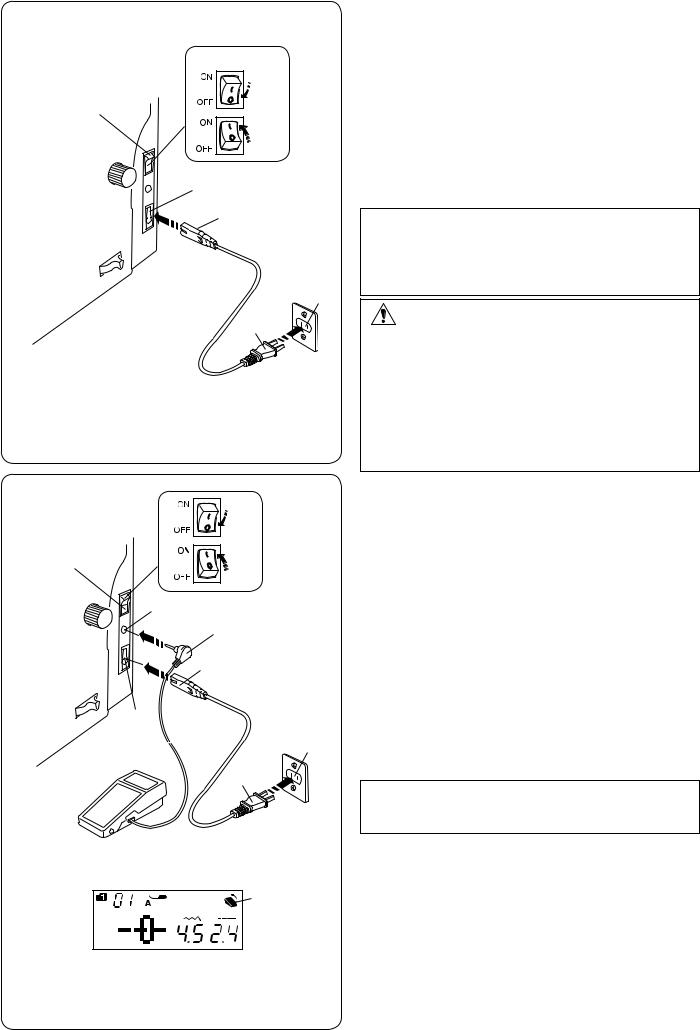
GeTTING ReADY to SeW
Connecting the Power Supply
z First make sure the power switch q is off.
zx Insert the machine plug w of the power supply cord
into the machine socket e.
q |
|
c Insert the power supply plug r into the wall outlet t, |
|
c |
and turn the power switch q on. |
||
|
|||
|
qPower switch |
||
|
|
||
|
|
wMachine plug |
|
|
|
eMachine socket |
|
e |
|
rPower supply plug |
|
|
tWall outlet |
||
|
|
||
w |
|
NOTE: |
|
|
|
Make sure to use the power supply cable that came |
|
|
|
with the machine. |
|
|
|
If you turn off the power switch, wait for 5 seconds |
|
|
|
before turning it on again. |
|
|
|
t |
|
r |
|
WARNING: |
|
|
While in operation, always keep your eyes on the |
||
|
|
sewing area, and do not touch any moving parts such |
|
|
|
as the thread take-up lever, handwheel or needle. |
|
|
|
Always turn off the power switch and unplug the |
|
|
|
machine from the power supply: |
-when leaving the machine unattended.
-when attaching or removing parts.
-when cleaning the machine.
|
|
|
|
|
|
Do not place anything on the foot control. |
|
|
|
|
|
|
If you wish to use the foot control, insert the pin |
|
|
|
z |
|
|
connector into the jack on the machine. |
|
|
|
|
|
z First make sure the power switch q is off. |
|
|
|
|
|
|
|
|
|
|
|
|
|
|
x Insert the pin connector w into the jack e on the |
|
|
|
v |
|
|
machine. |
q |
|
|
|
|
c Insert the machine plug r of the power supply cord |
|
|
|
|
|
|
||
|
|
|
|
|
|
into the machine socket t. |
|
|
|
|
|
|
v Insert the power supply plug y into the wall outlet u, |
e |
|
|
|
|
|
and turn the power switch on. |
|
|
w |
|
|
|
The foot control sign i will be displayed when the |
|
|
|
|
|
foot control is connected to the machine. |
|
|
|
|
|
|
|
|
|
r |
|
|
|
|
qPower switch |
|
|
|
|
|
wPin connector |
|
|
|
|
|
|
|
|
|
|
|
|
|
|
eJack |
t |
|
|
|
|
|
rMachine plug |
|
|
|
|
|
tMachine socket |
|
|
|
|
|
|
|
|
|
|
|
|
|
u |
yPower supply plug |
|
|
|
|
|
uWall outlet |
|
|
|
|
|
|
|
|
|
|
|
y |
|
|
iFoot control sign |
|
|
|
|
|
NOTE: |
|
|
|
|
|
|
|
|
|
|
|
|
|
|
The start/stop button does not work when the foot |
|
|
|
|
|
|
control is connected. |
|
|
|
|
|
|
Operating Instructions: |
|
|
|
|
|
|
The symbol “O” on a switch indicates the “off” position of |
|
|
|
|
i |
|
the switch. |
|
|
|
|
|
For the U.S.A. and Canada only |
|
|
|
|
|
|
|
|
|
|
|
|
|
|
Polarized plug (one blade wider than the other): |
|
|
|
|
|
|
To reduce the risk of electric shock, this plug is intended |
|
|
|
|
|
|
to fit in a polarized outlet only one way. If it does not fit |
|
|
|
|
|
|
fully in the outlet, reverse the plug. If it still does not fit, |
|
|
|
|
|
|
contact a qualified electrician to install the proper outlet. |
|
|
|
|
|
|
Do not modify the plug in any way. |
6

Machine Operating Buttons
|
|
|
|
|
|
|
|
|
|
|
|
|
|
|
|
|
|
|
q Start/stop button |
|||
|
|
|
|
|
|
|
|
|
|
|
|
|
|
|
|
|
|
|||||
|
|
|
|
|
|
|
|
|
|
|
|
|
|
|
|
|
|
|
Press this button to start or stop the machine. |
|||
|
|
|
|
|
|
|
|
|
|
|
|
|
|
|
|
|
|
|
The machine starts running slowly for the first few |
|||
|
|
|
|
|
|
|
|
|
|
|
|
|
|
|
|
|
|
|
stitches, it then runs at the speed set by the speed |
|||
|
|
|
|
|
|
|
|
|
|
|
|
|
|
|
|
|
|
|
control slider. The machine runs slowly as long as this |
|||
|
|
|
|
|
|
|
|
|
|
|
|
|
|
|
t |
|
|
|
button is pressed. |
|||
|
|
|
|
|
|
|
|
|
|
|
|
|
|
|
|
|
The button will turn red when the machine is running, and |
|||||
|
|
|
|
|
|
|
|
|
|
|
|
|
|
|
|
|
|
|
||||
|
|
|
|
|
|
|
|
|
|
|
|
|
r |
|
|
|
|
green when it has been stopped. |
||||
|
|
|
|
|
|
|
|
|
|
|
|
|
|
|
|
|
Pressing and holding this button while sewing will slow |
|||||
|
|
|
|
|
|
|
|
|
|
|
|
|
|
|
|
|
|
|
||||
q |
|
|
|
|
|
|
|
|
|
e |
|
|
|
|
down the sewing speed and the machine will stop when |
|||||||
|
|
|
|
|
|
|
|
w |
|
|
|
|
the button is released. |
|||||||||
|
|
|
|
|
|
|
|
|
|
|
|
|
|
|||||||||
|
|
|
|
|
|
|
|
|
|
|
|
|
|
|
|
|
|
|||||
|
|
|
|
|
|
|
|
|
|
NOTE: |
||||||||||||
|
|
|
|
|
|
|
|
|
|
|
|
|
|
|
|
|
|
|
|
|
||
|
|
|
|
|
q |
|
|
|
|
|
|
|
|
|
|
|
|
|
• The start/stop button cannot be used when the |
|||
|
|
|
|
|
|
|
|
|
|
|
|
|
|
|
foot control is connected to the machine. |
|||||||
|
|
|
|
|
|
|
|
|
|
|
|
|
|
|
|
|
|
|
||||
|
|
|
|
|
|
|
|
|
|
|
|
|
|
|
|
|
|
|
|
|
• The machine will not run and the presser foot mark |
|
|
|
|
|
|
|
|
|
y |
|
|
|
|
|
|
|
|||||||
|
|
|
|
|
|
|
|
|
|
|
|
|
|
|
|
y will blink if you start the presser foot in the up |
||||||
|
|
|
|
|
|
|
|
|
|
|
|
|
|
|
|
|
|
|
|
|
|
position. Lower the presser foot and press the |
|
|
|
|
|
|
|
|
|
|
|
|
|
|
|
|
|
|
|
|
|
|
start/stop button. |
|
|
|
|
|
|
|
|
|
|
|
|
|
|
|
|
|
|
|
|
|
|
|
|
|
|
|
|
|
|
|
|
|
|
|
|
|
|
|
|
|
|
|
|
• You can select the desired start-up speed from |
|
|
|
|
|
|
|
|
|
|
|
|
|
|
|
|
|
|
|
|
|
|
|
slow, medium or high (refer to page 26). |
|
|
|
|
|
|
|
|
|
|
|
|
|
|
|
|
|
|
|
|
|
|
|
|
|
|
|
|
|
|
|
|
|
|
|
|
|
|
|
|
|
|
|
w Reverse button |
||
|
|
|
|
|
w |
|
|
|
|
|
|
|
|
|
|
|
|
|
When sewing stitch pattern 01, 04-07, 11-13, 01S, |
|||
|
|
|
|
|
|
|
|
|
|
|
|
|
|
|
04S-07S (MODE 1) or 37, 38 (MODE 2), the machine will |
|||||||
|
|
|
|
|
|
|
|
|
|
|
|
|
|
|
|
|
|
|
|
|||
|
|
|
|
|
|
|
|
|
|
|
|
|
|
|
|
|
|
|
|
sew in reverse as long as the reverse button is pressed. |
||
|
|
|
|
|
|
|
|
|
|
|
|
|
|
|
|
|
|
|
|
If stitch pattern 01, 04-07, 11-13, 01S, 04S-07S (MODE |
||
|
|
|
|
|
|
|
|
|
|
|
|
|
|
|
|
|
|
|
|
|||
|
|
|
|
|
|
|
|
|
|
|
|
|
|
|
|
|
|
|
|
1) or 37, 38 (MODE 2) has been selected and the foot |
||
|
|
|
|
|
|
|
|
|
|
|
|
|
|
|
|
|
|
|
|
control is not connected, the machine will start sewing in |
||
|
|
|
|
|
|
|
|
|
|
|
|
|
|
|
|
|
|
|
|
reverse as long as the reverse button is pressed. |
||
|
|
|
|
|
|
|
|
|
|
|
|
|
|
|
|
|
|
|
|
If you press the reverse button when sewing any other |
||
|
|
|
|
|
|
|
|
|
|
|
|
|
|
|
|
|
|
|
|
patterns, the machine will immediately sew locking |
||
|
|
|
|
|
|
|
|
|
|
|
|
|
|
|
|
|
|
|
|
stitches and automatically stop. |
||
|
|
|
|
|
|
e |
|
|
|
|
|
|
|
e Auto-lock button |
||||||||
|
|
|
|
|
|
|
|
|
|
|
|
|
When sewing stitch pattern 01, 04-07, 11-13, 01S, |
|||||||||
|
|
|
|
|
|
|
|
|
|
|
|
|
|
|
|
|
|
|
|
|||
|
|
|
|
|
|
|
|
|
|
|
|
|
|
|
|
|
|
|
|
04S-07S (MODE 1) or 37, 38 (MODE 2), the machine will |
||
|
|
|
|
|
|
|
|
|
|
|
|
|
|
|
|
|
|
|
|
immediately sew locking stitches and automatically stop |
||
|
|
|
|
|
|
|
|
|
|
|
|
|
|
|
|
|
|
|
|
when the auto-lock button is pressed. |
||
|
|
|
|
|
|
|
|
|
|
|
|
|
|
|
|
|
|
|
|
When sewing all other patterns, the machine will sew to |
||
|
|
|
|
|
|
|
|
|
|
|
|
|
|
|
|
|
|
|
|
the end of the current pattern, sew locking stitches and |
||
|
|
|
|
|
|
|
|
|
|
|
|
|
|
|
|
|
|
|
|
|||
|
|
|
|
|
|
|
|
|
|
|
|
|
|
|
|
|
|
|
|
stop automatically. |
||
|
|
|
|
|
|
|
|
|
|
|
|
|
|
|
|
|
|
|
|
The machine will trim the threads automatically after |
||
|
|
|
|
|
|
|
|
|
|
|
|
|
|
|
|
|
|
|
|
locking the stitch when the auto thread cutting option is |
||
|
|
|
|
|
|
|
|
|
|
|
|
|
|
|
|
|
|
|
|
turned on. |
||
|
|
|
|
|
|
r |
|
|
|
|
|
|
|
|
|
r Needle up/down button |
||||||
|
|
|
|
|
|
|
|
|
|
|
|
|
|
|
Press this button to bring the needle bar up or down. |
|||||||
|
|
|
|
|
|
|
|
|
|
|
|
|
|
|
|
|
|
|
|
|||
|
|
|
|
|
|
|
|
|
|
|
|
|
|
|
|
|
|
|
|
The machine will stop with the needle in down position. |
||
|
|
|
|
|
|
|
|
|
|
|
|
|
|
|
|
|
|
|
|
However, you can change the needle stop position in the |
||
|
|
|
|
|
|
|
|
|
|
|
|
|
|
|
|
|
|
|
|
|||
|
|
|
|
|
|
|
|
|
|
|
|
|
|
|
|
|
|
|
|
setting mode (refer to page 26). |
||
|
|
|
|
|
t |
|
|
|
|
|
|
|
|
|
t Thread cutter button |
|||||||
|
|
|
|
|
|
|
|
|
|
|
|
|
|
Press this button when you finish sewing to trim the |
||||||||
|
|
|
|
|
|
|
|
|
|
|
|
|
|
|
|
|
|
|
|
|||
|
|
|
|
|
|
|
|
|
|
|
|
|
|
|
|
|
|
|
|
threads. The needle bar automatically rises after trimming |
||
|
|
|
|
|
|
|
|
|
|
|
|
|
|
|
|
|
|
|
|
the threads (refer to page 29). |
||
|
|
|
|
|
|
|
|
|
|
|
|
|
|
|
|
|
|
|
|
|
|
|
|
|
|
|
|
|
|
|
|
|
|
|
|
|
|
|
|
|
|
|
|
NOTE: |
|
|
|
|
|
|
|
|
|
|
|
|
|
|
|
|
|
|
|
|
|
|
Use the thread cutter on the face cover if the thread is |
|
|
|
|
|
|
|
|
|
|
|
|
|
|
|
|
|
|
|
|
|
|
#30 or thicker (refer to page 29). |
|
|
|
|
|
|
|
|
|
|
|
|
|
|
|
|
|
|
|
|
|
|
|
|
|
|
|
|
|
|
|
|
|
|
|
|
|
|
|
|
|
|
|
|
|
|
|
7

Controlling Sewing Speed
Speed control slider
You can limit the maximum sewing speed with the speed control slider according to your sewing needs.
To increase the sewing speed, move the slider to the right.
To decrease the sewing speed, move the slider to the left.
Foot control
Pressing on the foot control can vary sewing speed. The harder you press the foot control, the faster the machine runs.
NOTE:
The machine runs at the maximum speed set by the speed control slider when the foot control is fully depressed.
Operating Instructions:
Foot control model YC-485EC-1 is for use with this sewing machine.
8
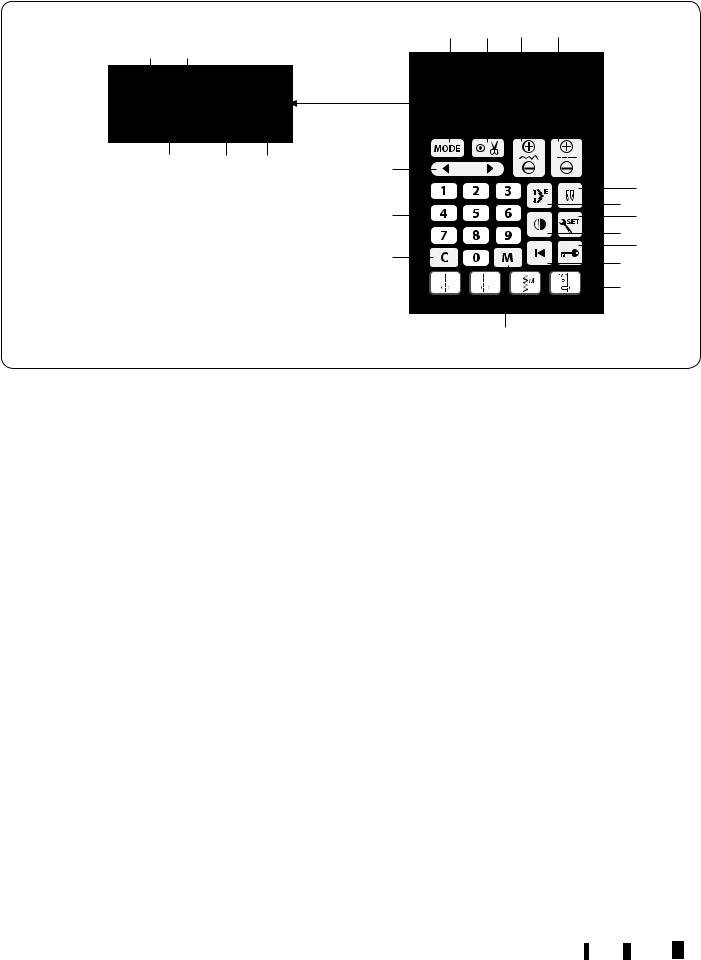
i o !0 !1
rt
e








 q
q





w |
y u |
!2 |
|
|
|
|
|
|
|
|
!9 |
|
|
!3 |
!6 |
|
|
@0 |
!7
@1
!4 |
!8 |
|
|
|
!5 |
|
@2 |
Function Keys
q LCD screen
The LCD screen shows the following information when the machine is turned on:
w Stitch pattern e Mode
r Stitch pattern number
t Recommended type of presser foot y Stitch width
uStitch length
i MODE key (refer to page 25)
Press the MODE key to select the mode.
When the power is turned on, the direct pattern selection (MODE 1) is set automatically.
o Auto thread cutting key (refer to page 72)
Press this key if you wish to cut the threads automatically after finish sewing with a locking stitch.
When programming a pattern combination, press this key to cut the threads automatically after finish sewing.
!0Stitch width adjusting key (refer to pages 30, 39, 48) Press this key to alter the stitch width.
!1Stitch length adjusting key (refer to pages 30, 39, 48) Press this key to alter the stitch length.
!2Cursor key (refer to pages 79, 80)
Press “ ” or “
” or “  ” to move the cursor to check or edit the pattern combination.
” to move the cursor to check or edit the pattern combination.
!3Number keys (refer to page 24)
Enter a 2-digit pattern number to select the desired stitch pattern in modes 1 to 6.
!4Clear key (refer to pages 26, 80)
Press the clear key to clear the memorized stitch pattern. Press and hold this key until the buzzer sounds to delete the whole pattern combination.
!5Memory key (refer to pages 70)
Press this key to register programmed pattern combinations.
Up to 50 stitch patterns combination can be memorized.
!6Elongation key (refer to page 67)
Press this key to elongate satin stitch patterns.
!7Mirror image key (refer to pages 73)
Press this key to sew a mirror image of the selected pattern.
!8Startover key (refer to page 74)
Press this key to sew a pattern combination from the beginning.
!9Twin needle key (refer to page 69)
Press this key when sewing with a twin needle.
@0Set key (refer to page 25)
Press this key to enter the setting mode for customizing the machine settings.
@1Lockout key (refer to page 13)
Press this key to lockout the machine when threading the machine, replacing the accessories etc.
To reduce the risk of injury, all the buttons and keys are deactivated.
To unlock the machine, press this key again.
@2Direct pattern selection keys (refer to page 24)
You can select the stitch patterns 01 , 04
, 04 , 11
, 11 and 06
and 06
 in MODE 1 directly.
in MODE 1 directly.
When the straight stitch needle plate is being attached, you can select the stitch patterns 01S , 04S
, 04S or 06S
or 06S

 only.
only.
9
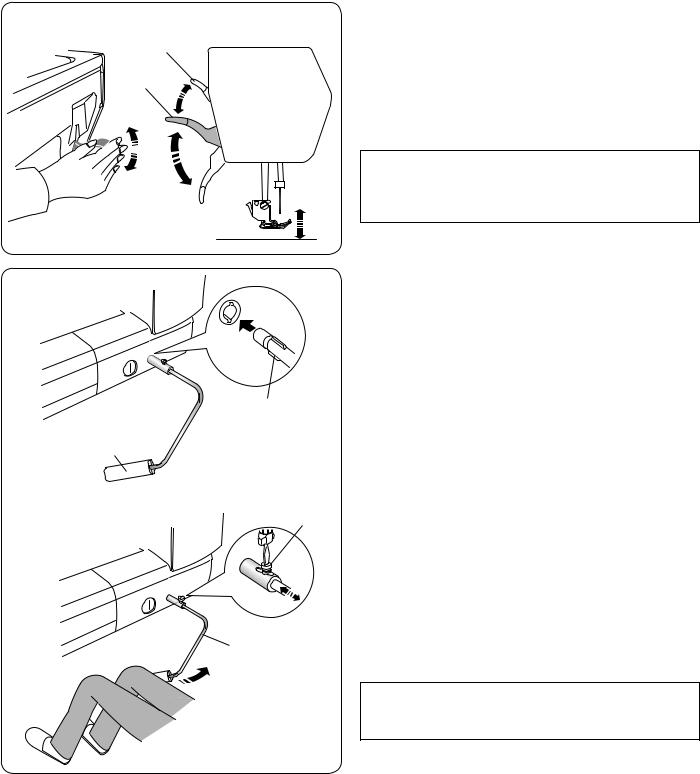
|
Raising and Lowering the Presser Foot |
|
The presser foot lifter raises and lowers the presser foot. |
w |
q Presser foot lifter |
|
You can raise the presser foot higher than the normal up |
q |
position. This allows for changing the needle plate, and |
|
also helps you to place thick layers of fabrics under the |
|
foot. |
|
w Extra lifted position |
|
NOTE: |
|
Do not turn the hand wheel of press the up/down |
|
needle button when the presser foot is in the extra |
|
lifted position. |
Knee Lifter
The knee lifter is extremely helpful when sewing
 e patchwork, quilting etc, since it allows you to handle the fabric while your knee controls the presser foot.
e patchwork, quilting etc, since it allows you to handle the fabric while your knee controls the presser foot.
Attaching the knee lifter
Match the ribs on the knee lifter with the notches in the knee lifter socket and insert the knee lifter.
wq Knee lifter w Rib
e Knee lifter socket
q
Adjusting the knee lifter
The angle of the knee lifter can be adjusted to fit you. Loosen the setscrew and slide the angle bar in or out to
radjust the angle of the knee lifter.
Tighten the setscrew to secure the angle bar.
|
r Setscrew |
|
t Angle bar |
|
Using the knee lifter |
|
Push the knee lifter with your knee to easily move the |
|
presser foot up and down. |
t |
You can control how high the foot rises by the amount of |
|
knee pressure you exert. |
|
NOTE: |
|
Do not touch the knee lifter while stitching, otherwise |
|
the fabric will not be fed smoothly. |
10

|
Adjusting the Foot Pressure |
|
The foot pressure can be adjusted with the foot pressure |
|
dial located under the top cover. |
|
The dial has 7 setting positions from 1 to 7. |
|
For ordinary sewing, set 5 at the setting mark. |
q |
q Foot pressure dial |
w Setting mark |
|
|
Reduce the pressure when sewing fine synthetics and |
|
stretch fabrics. |
|
To reduce the pressure, set the dial at a lower number. |
|
Increase the pressure when sewing heavy weight fabrics. |
|
To increase the pressure, set the dial at a higher number. |
w
Dropping the Feed Dog
The feed dog can be lowered for basting, sewing on buttons, free motion quilting etc.
Shift the drop feed lever toward you to lower the feed dog.
q Drop feed lever
w Feed dog
w
Shift the drop feed lever away from you to raise the feed dog, it will return to the up position when you start the machine.
q
NOTE:
If you start the machine with the feed dog lowered, a message will appear on the LCD screen.
The machine will not run with the feed dog lowered when selected following pattern numbers; 23 to 32, 34 to 36 in MODE 1, stitch patterns in MODE 3 to 6.
11
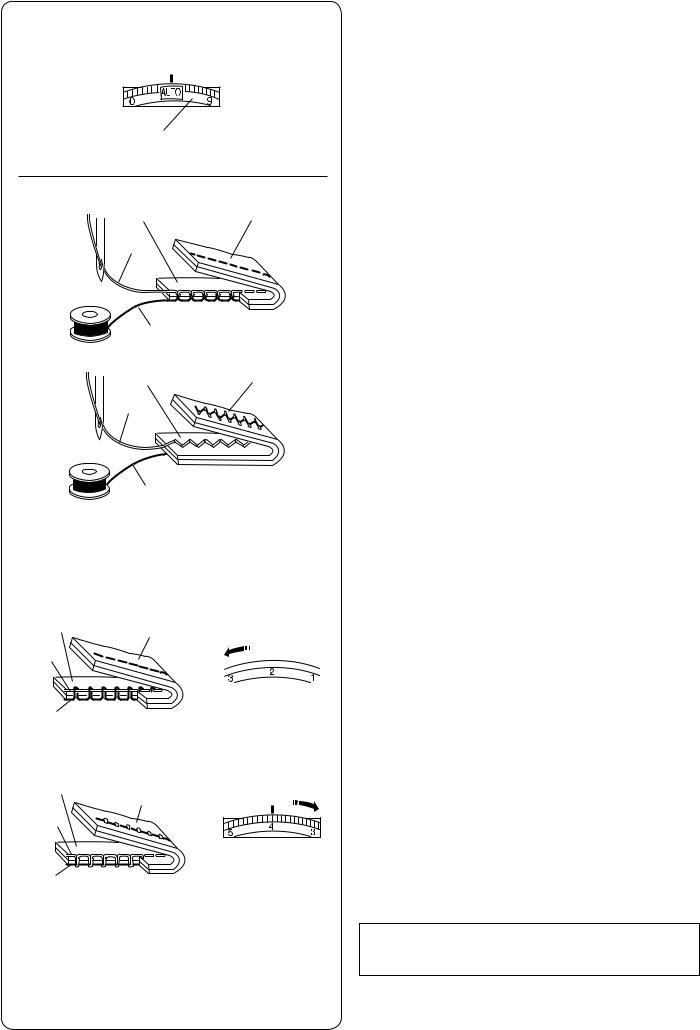
Balancing Thread Tension
Auto-thread tension
For general sewing, set the thread tension dial at AUTO, which covers a wide range of sewing conditions.
q Thread tension dial
q
Balanced thread tension
w q For straight stitch sewing, both needle and bobbin threads will join at the middle of the fabrics.
e
r |
|
For zigzag stitch sewing, the needle thread will appear |
|
|
|
slightly on the wrong side of the fabric. |
|
w |
q |
q Wrong side of fabric |
|
w Right side of fabric |
|||
|
|
||
e |
|
e Needle thread |
|
|
r Bobbin thread |
||
|
|
|
r |
|
|
|
|
|
|
|
|
|
|
|
|
|
|
|
|
|
Manual thread tension adjustment |
|
|
|
|
|
|
|
|
|
|
|
|
|
|
|
|
|
|
|
|
|
|
|
|
|
|
|
|
|
|
|
|
|
|
|
|
|
|
|
You may also need to adjust tension manually depending |
|
|
|
|
|
|
|
|
|
|
|
|
|
|
|
|
|
|
|
on the sewing conditions such as the type of fabric and |
|
|
|
|
|
|
|
|
|
|
|
|
|
|
|
|
|
|
|
number of layers. |
|
|
|
|
|
|
|
|
|
|
|
|
|
|
|
|
|
|
|
If the needle thread is too tight, the bobbin thread |
|
|
|
|
|
|
|
|
|
|
|
|
|
|
|
|
|
|
|
appears on the right side of the fabric. |
|
|
|
|
|
|
|
|
|
|
|
|
|
|
|
|
|
|
|
q Wrong side of fabric |
w |
q |
|
|
|
|
|
|
|
|
|
|
|
|
|
|
|
|
|
w Right side of fabric |
|
|
|
|
|
|
|
|
|
|
|
|
|
|
|
|
|
|
e Needle thread |
|
e |
|
|
|
|
|
|
|
|
|
|
|
|
|
|
|
|
|
|
|
|
|
|
|
|
|
|
|
|
|
|
|
|
|
|
|
|
|
r Bobbin thread |
|
|
|
|
|
|
|
|
|
|
|
|
|
|
|
|
|
|
|
||
|
|
|
|
|
|
|
|
|
|
|
|
|
|
|
|
|
|
|
Turn the thread tension dial to a lower number to |
|
|
|
|
|
|
|
|
|
|
|
|
|
|
|
|
|
|
|
|
|
|
|
|
|
|
|
|
|
|
|
|
|
|
|
|
|
|
|
decrease the thread tension. |
r |
|
|
|
|
|
|
|
|
|
|
|
|
|
|
|
|
|
|
|
w |
If the needle thread is too loose, the needle thread loops |
|
on the underside of the fabric. |
||
q |
||
e |
q Wrong side of fabric |
|
w Right side of fabric |
||
|
||
|
e Needle thread |
|
|
r Bobbin thread |
|
r |
Turn the thread tension dial to a higher number to |
|
|
increase the thread tension. |
|
|
NOTE: |
|
|
Manual thread tension adjustment may be required |
|
|
when the stitch width is set more than “7.0”. |
12
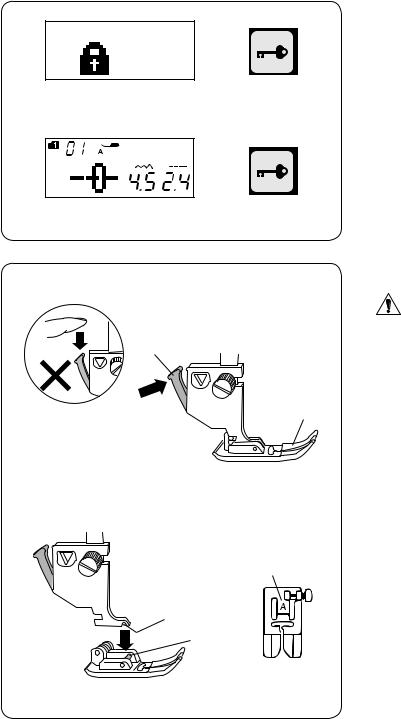
Lockout Key
Press this key to lockout the machine when threading the machine, replacing the accessories etc.
To reduce the risk of injury, all the buttons and keys are deactivated.
To unlock the machine, press this key again.
Changing the Presser Foot
|
CAUTION: |
|
|
Always make sure to press the lockout key to lockout |
|
q |
the machine or turn the power switch off before |
|
replacing the presser foot. |
||
|
||
|
|
Raise the needle to its highest position and raise the presser foot lifter.
w Press the black lever on the back of the foot holder. The presser foot will drop off.
q Lever
w Presser foot
|
Attaching the presser foot |
|
Place the presser foot so that the pin on the foot lies just |
t |
under the groove of the foot holder. |
|
Lower the presser bar to lock the foot in place. |
e |
Each foot is marked with an identification letter. |
e Groove |
|
r |
r Pin |
|
t Identification letter |
13
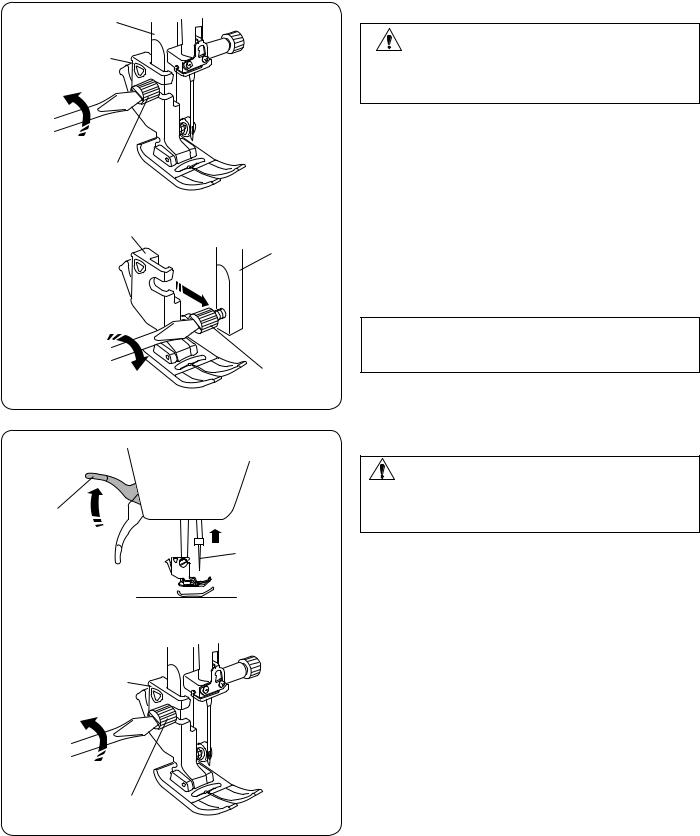
Removing and Attaching the Foot Holder
q
|
CAUTION: |
|
w |
Always make sure to press the lockout key to lockout |
|
|
the machine or turn the power switch off before |
|
|
replacing the presser foot. |
|
|
Removing the foot holder |
|
|
Raise the needle to its highest position. |
|
|
Raise the presser foot and loosen the setscrew. |
|
e |
Remove the foot holder. |
|
|
q Presser bar |
|
|
w Foot holder |
|
w |
e Setscrew |
|
|
||
|
q |
|
|
Attaching the foot holder |
|
|
Attach the foot holder to the presser bar from the rear. |
|
|
Tighten the thumbscrew securely with the screwdriver. |
|
|
NOTE: |
|
|
Lower the presser foot when loosening and tightening |
|
|
the thumbscrew if it is hard to access. |
|
|
e |
|
|
Dual Feed Foot |
|
z |
|
|
|
CAUTION: |
|
|
Always make sure to press the lockout key to lockout |
|
q |
the machine or turn the power switch off before |
|
replacing the presser foot. |
||
|
||
w |
z Raise the needle to its highest position. |
|
|
Raise the presser foot lifter. |
|
|
qPresser foot lifter |
|
|
w Needle |
|
x |
x Loosen the setscrew. |
|
Remove the foot holder. |
||
|
||
e |
eFoot holder |
|
rSetscrew |
r
14

cv
t
u
yi
b
n
w
cAttach the dual feed foot holder to the presser bar.
Tighten the setscrew lightly with your finger. tDual feed link
yDual feed foot holder uUpper feed drive iDual feed foot
vPush the dual feed link to engage it with upper feed drive.
bLower the presser foot lifter. Lower the needle to the lowest position by turning the handwheel.
n Tighten the setscrew securely with the screwdriver.
Replacing the dual feed foot
Pull the foot toward you to remove it.
Insert the pins of the foot into the slits of the foot holder and gently push the foot until it snaps into place.
q Pin
w Slit
q
15

|
Replacing the Needle Plate |
z |
Use the straight stitch needle plate when sewing fine |
|
fabrics or sewing with the dual feed foot. |
q |
CAUTION: |
|
Always make sure to press the lockout key to lockout |
||
|
||
|
the machine or turn the power switch off before |
|
w |
replacing the needle plate. |
|
|
z Raise the needle to the highest position. |
|
|
Raise the presser foot lifter to the extra lifted position. |
|
x |
qPresser foot lifter |
|
wNeedle |
||
r |
||
|
||
|
x Slide the extension table to the left to remove it. |
|
|
Push down the needle plate release lever and the |
|
|
needle plate will snap off. |
|
|
eNeedle plate release lever |
|
|
rNeedle plate |
|
e |
c |
c Place the straight stitch needle plate on the machine. |
|
Set the left edge of the needle plate into the opening. |
v |
|
v Push down on the needle plate mark until the needle |
|
|
plate locks in place. |
|
t |
Lower the presser foot to the normal up position. |
|
|
Press the lockout key to unlock or turn the power switch on. Make sure the straight stitch is automatically selected.
Turn the hand wheel slowly and make sure that the needle does not hit the needle plate.
t Needle plate mark
CAUTION:
Never press the needle plate release lever while running the machine.
16
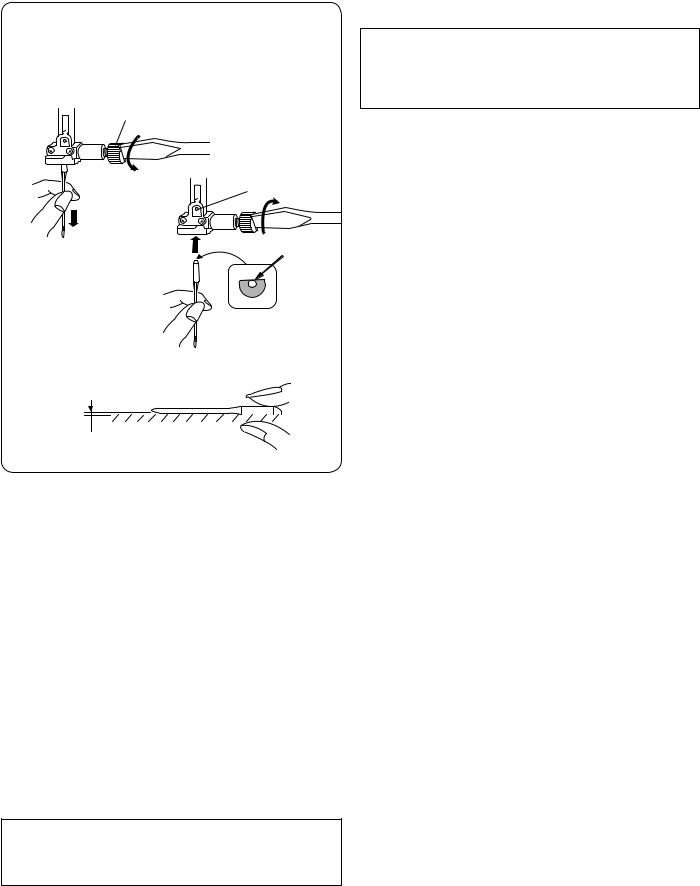
Changing Needles
 CAUTION:
CAUTION:
Always make sure to press the lockout key to lockout the machine or turn the power switch off before changing the needle.
q
Raise the needle by pressing the needle up/down button and lower the presser foot.
Turn the power switch off.
e |
|
Loosen the needle clamp screw and remove the needle |
|
from the clamp. |
|
|
|
|
|
|
q Needle clamp screw |
|
w |
Insert a new needle into the needle clamp with the flat |
|
side of the needle to the rear. |
|
|
|
|
|
|
When inserting the needle into the needle clamp, push it |
|
|
up against the stopper pin and tighten the needle clamp |
|
|
screw firmly with a screwdriver. |
|
|
w Flat side |
|
|
e Stopper pin |
To check needle straightness, place the flat side of the needle onto something flat (a needle plate, glass etc.) The gap between the needle and the flat surface should
r 

 be consistent.
be consistent.
Never use a blunt needle. r Gap
Fabric |
Thread |
Needle |
||
|
Lawn |
|
|
|
|
Georgette |
Silk #80-100 |
Blue tip needle |
|
Fine |
Tricot |
Cotton #80-100 |
Universal needle |
|
|
Organza |
Synthetic #80-100 |
#9/65-11/75 |
|
|
Crepe |
|
|
|
|
Sheeting |
Silk #50 |
Red tip needle |
|
|
Jersey |
Purple tip needle |
||
Medium |
Cotton #50-80 |
|||
Broadcloth |
Universal needle |
|||
|
Fleece |
Synthetic #50-80 |
#11/75-14/90 |
|
|
Denim |
Silk #30-50 |
Red tip needle |
|
Heavy |
Tweed |
Purple tip needle |
||
Cotton #40-50 |
||||
weight |
Coating |
Universal needle |
||
Synthetic #40-50 |
||||
|
Quilting |
#14/90-16/100 |
||
NOTE:
1 x twin needle, 2 x blue tip needle (#11/75), 1 x red tip needle (#14/90) and 1 x purple tip needle (#14/90) are included in the needle case (Part No. 859856005).
Fabric and Needle Chart
•For general sewing, use red needle.
•Fine threads and needles should be used for sewing fine fabrics.
•In general, use the same thread for both needle and bobbin.
•Use a blue tip needle for sewing fine fabrics, stretch fabrics, tricot and buttonholes to prevent skipped stitches.
•Use a purple tip needle for sewing knits, free quilting and across the hem to prevent skipped stitches.
•Use a stabilizer or interface to stretch or fine fabrics to prevent seam puckering.
•Always test the thread and needle size on a small piece of the same fabric you will use for actual sewing.
17
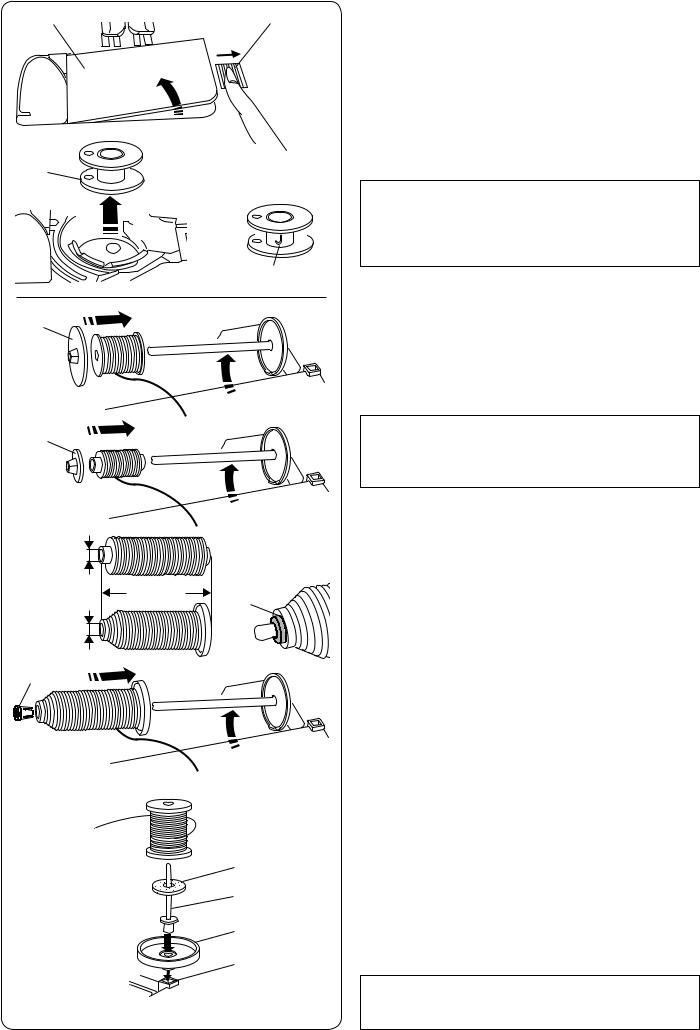
w |
|
|
q |
Winding the Bobbin |
|
|
Removing the Bobbin |
||
|
|
|
|
|
|
|
|
|
Slide the hook cover release button to the right, and |
|
|
|
|
remove the hook cover plate. |
|
|
|
|
q Hook cover release button |
|
|
|
|
w Hook cover plate |
|
|
|
|
Lift out the bobbin from the bobbin holder. |
|
|
|
|
e Bobbin |
e |
|
|
|
|
|
|
|
|
NOTE: |
|
|
|
|
Use the J plastic bobbins for horizontal hook (marked |
|
|
|
|
with “J” r). Using other bobbins, such as pre-wound |
|
|
|
|
paper bobbins, may cause stitching problems and/ or |
|
|
|
|
damage to the bobbin holder. |
|
|
|
r |
|
q |
|
|
|
Setting the spool of thread |
|
|
|
Lift up the spool pin. Place the spool of thread on the |
|
|
|
|
|
spool pin with the thread coming off the spool as shown. |
|
|
|
|
Attach the large spool holder, and press it firmly against |
|
|
|
|
the spool of thread. |
|
|
|
|
q Large spool holder |
|
|
|
|
NOTE: |
w |
|
|
|
Use the small spool holder to hold narrow or small |
|
|
|
|
spools of thread. |
|
|
|
|
w Small spool holder |
|
|
|
|
Spool Holder (special) |
e |
|
|
|
Use the spool holder (special) when using a long spool of |
|
|
|
thread as shown. |
|
|
|
|
|
|
|
r |
|
|
e 9.5 - 10.5 mm (3/8 - 7/16˝) |
|
y |
|
r 70 - 75 mm (2-3/4 - 3˝) |
|
|
|
|
||
|
|
|
|
|
e |
|
|
|
Attach the spool holder (special) by inserting it into the |
|
|
|
|
hole of the spool of thread. Make sure there is no gap |
|
|
|
|
between the spool holder and the spool of thread. |
t |
|
|
|
t Spool holder (special) |
|
|
|
|
y No gap |
|
|
|
Extra spool pin |
|
|
|
|
|
|
|
Use the extra spool pin when you need to wind a bobbin |
|
|
|
without unthreading the machine while working on a |
|
|
|
sewing project. |
|
|
r |
Insert the extra spool pin into the spool supporter and |
|
|
then into the hole beside the horizontal spool pin. |
|
|
|
q |
Place the felt cushion on the spool pin and place a spool |
|
|
of thread on it as shown. |
|
|
|
|
|
|
|
|
q Extra spool pin |
|
|
w |
w Spool supporter |
|
|
||
|
|
|
e Hole for extra spool pin |
|
|
e |
r Felt cushion |
NOTE:
The extra spool pin is also used for twin needle sewing.
18
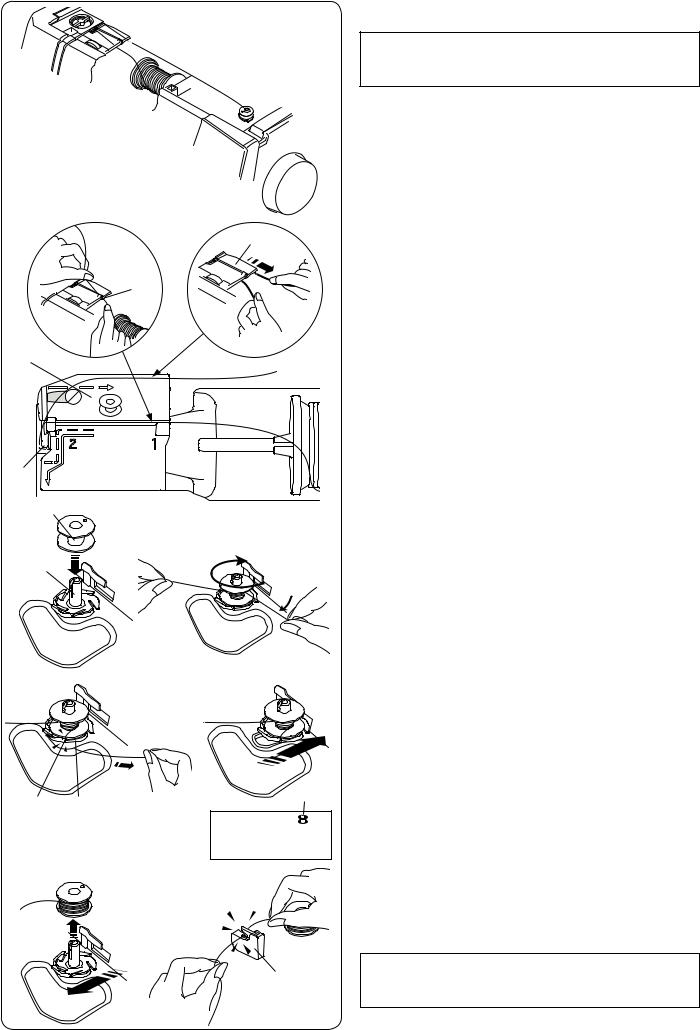
Winding the bobbin
NOTE:
Set the speed control slider at the fastest position (refer to page 8).
|
|
z Pull the thread from the spool. |
z |
x |
Hold the thread with both hands and pass the thread |
|
e |
into the guide slot q. |
|
|
q Guide slot |
|
q |
x Draw the thread to the left and forward around the |
|
|
thread guide w. |
|
|
Draw the thread to the rear and to the right around |
|
|
and under the guide plate e. |
e |
|
Firmly pull the thread to the right while holding it with |
|
both hands. |
|
|
|
|
|
|
w Thread guide |
|
|
e Guide plate |
w |
|
|
|
|
c |
r |
v |
|
c Put the bobbin on the bobbin winder spindle. |
|
|
|
|
rBobbin |
|
|
|
|
tBobbin winder spindle |
|
t |
|
|
v Pass the thread to the bobbin. |
|
|
|
|
|
|
|
|
|
Hold the thread with both hands and wind it around |
|
|
|
|
the bobbin clockwise several times. |
|
|
|
|
b Insert the thread into one of the slits u of the flange |
b |
|
n |
|
plate y and pull the thread to cut. |
|
|
yFlange plate |
||
|
|
|
|
|
|
|
|
|
uSlit |
|
|
|
|
n Push the bobbin to the right. The bobbin mark |
|
|
|
|
appears on the LCD screen. |
|
|
|
|
iBobbin mark |
|
u |
y |
i |
m Start the machine. |
|
|
|||
|
|
|
|
Stop the machine when the bobbin is fully wound and |
|
|
|
|
stops spinning. |
|
|
|
|
Return the bobbin winder spindle to its original |
m , |
|
|
position. |
|
|
|
|
||
|
|
|
|
, Remove the bobbin. Cut the thread with bobbin thread |
|
|
|
|
cutter B o. |
|
|
|
|
oBobbin thread cutter B |
|
|
o |
|
NOTE: |
|
|
|
For safety purposes, the machine will automatically |
|
|
|
|
|
stop 1.5 minutes after starting bobbin winding. |
19

z
w
r
x
c
i
Correct
i
v o
!0 
b
e
q
t
 y
y
u
Wrong
i
r
Inserting the bobbin
zPress the lockout key.
Place a bobbin in the bobbin holder with the thread running off counterclockwise as shown on the hook cover plate.
qLockout key wEnd of thread eBobbin holder rHook cover plate
xHold the bobbin with your fingertip so it does not rotate.
Guide the thread into the front notch of the bobbin holder.
Pull the thread to the left to pass it under the guide. tFront notch
yGuide
cDraw the thread to the left to pass it into the guide path marked “1”.
Make sure that the thread comes out from the side notch of the bobbin holder.
uGuide path 1 iSide notch
NOTE:
If the thread does not come out from the side notch, rethread from step z.
vContinue to draw the thread along the guide path marked “2” and pull the thread to the right through the slit. The thread will be cut to a proper length and held in place.
oGuide path 2 !0Slit (Thread cutter)
bSet the left edge of the hook cover plate into opening.
Push down the hook cover plate to fit in place.
NOTE:
Unless otherwise noted, you can start sewing without drawing up the bobbin thread.
Refer to page 23 for how to draw up the bobbin thread.
20

v x z
b  c
c
n


z
 m
m
 q
q
w
x
e
e
c |
v |
y
t
 r
r
b n m
u
i
Threading the Machine
Raise the presser foot lifter to raise the presser foot. Turn the power switch on.
Press the needle up/down button to raise the take-up lever to the highest position.
Press the lockout key or turn the power switch off. Pass the thread in the order from z to m.
 CAUTION:
CAUTION:
Always make sure to press the lockout key to lockout the machine or turn the power switch off before threading the machine.
zHold the thread with both hands and pass the thread into the guide slot.
q Guide slot
xHold the thread with both hands and draw the thread around the corner of the guide.
Firmly pull the thread toward you along the right channel until the thread snaps.
w Corner of the guide e Right channel
cDraw the thread down along the right channel and around the bottom of the thread guide plate. Pull the thread up along the left channel.
e Right channel
r Thread guide plate t Left channel
vWhile holding the thread at the spool, firmly draw the thread up and to the back of the take-up lever. Draw the thread forward to slip it into the eye of the take-up lever.
y Eye of the take-up lever
bThen pull the thread down along the left channel and through the lower thread guide.
u Lower thread guide
nSlide the thread behind the needle bar thread guide on the left.
i Needle bar thread guide
mThread the needle with the needle threader (refer to the next page).
21

Built-in Needle Threader
z
|
|
NOTE: |
|
|
• The needle threader can be used with a #11 to #16 |
|
|
needle. |
|
|
Thread size 50 to 90 is recommended. |
|
|
• The needle threader cannot be used with the twin |
|
|
needle. |
|
q |
|
|
|
CAUTION: |
|
|
Always make sure to press the lockout key to lockout |
|
|
the machine or turn the power switch off before using |
|
|
the built-in needle threader. |
|
|
z Turn the power switch ON. |
|
|
Press the needle up/down button to raise the needle. |
|
|
Press the lockout key to lock the machine. |
|
|
Pull down the needle threader knob as far as it will go. |
|
|
The threader hook comes out through the needle eye |
|
|
from behind. |
|
|
q Needle up/down button |
w |
|
w Threader knob |
e |
e Threader hook |
|
|
|
|
x |
|
x Draw the thread from left to right, under the left guide, |
|
|
threader hook and right guide. |
|
|
Draw the thread around the right guide toward you. |
|
|
r Left guide |
|
|
t Right guide |
|
t |
|
r |
c |
c Raise the threader slowly so a loop of the thread is |
|
pulled up through the needle eye. |
|
y Threader loop |
|
y |
v |
v Remove the thread end through the needle eye to the |
|
rear. |
|
NOTE: |
|
The needle threader cannot be used with the twin |
|
needle. |
22
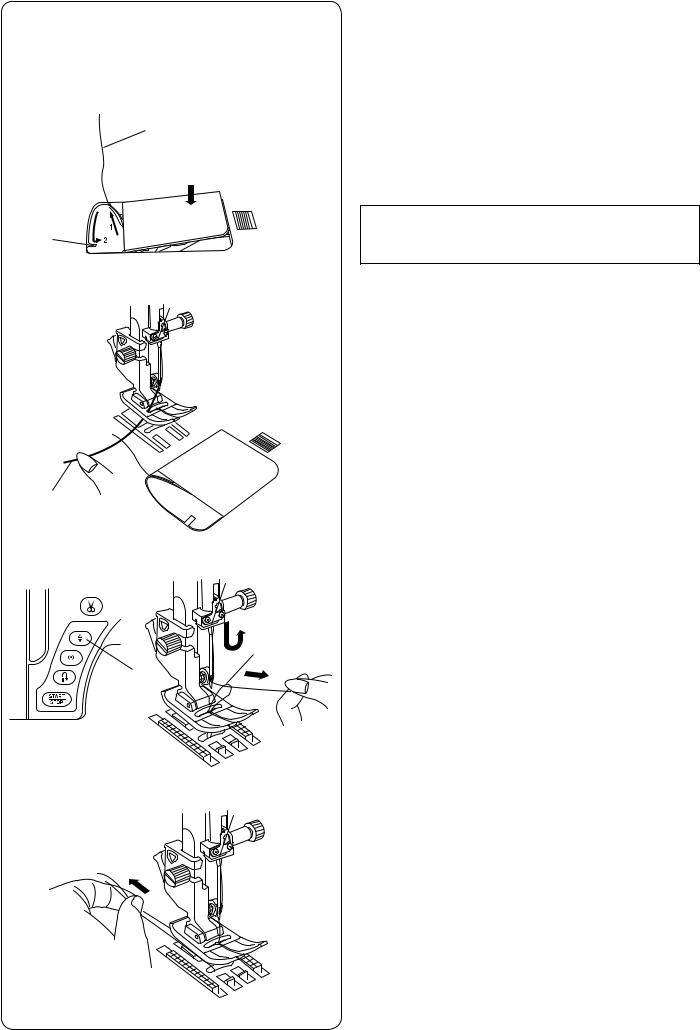
|
Drawing up the Bobbin Thread |
|
After using auto thread cutting or threading the bobbin |
|
holder, you can start sewing without drawing up the |
|
bobbin thread. |
|
However, you need to draw up the bobbin thread when |
z |
sewing gathering stitches etc. |
|
|
q |
z Remove the bobbin. Insert the bobbin into the bobbin |
|
holder again and rethread the bobbin holder according |
|
to the instructions on page 20, but leave a 10 cm (4˝) |
|
tail of bobbin thread as shown. |
|
qBobbin thread |
|
NOTE: |
w |
Do not cut the bobbin thread with the thread cutter. |
|
w Thread cutter |
x |
x Raise the presser foot. Hold the needle thread lightly |
|
with your left hand. |
|
eNeedle thread |
e
c |
c Press the needle up/down button twice to lower and |
|
raise the needle. |
|
Pull the needle thread to bring up the loop of bobbin |
|
thread. |
t |
rNeedle up/down button |
t Loop of bobbin thread |
|
r |
|
v |
v Pull both threads 10 cm (4˝) under and behind the |
|
presser foot. |
||
|
23
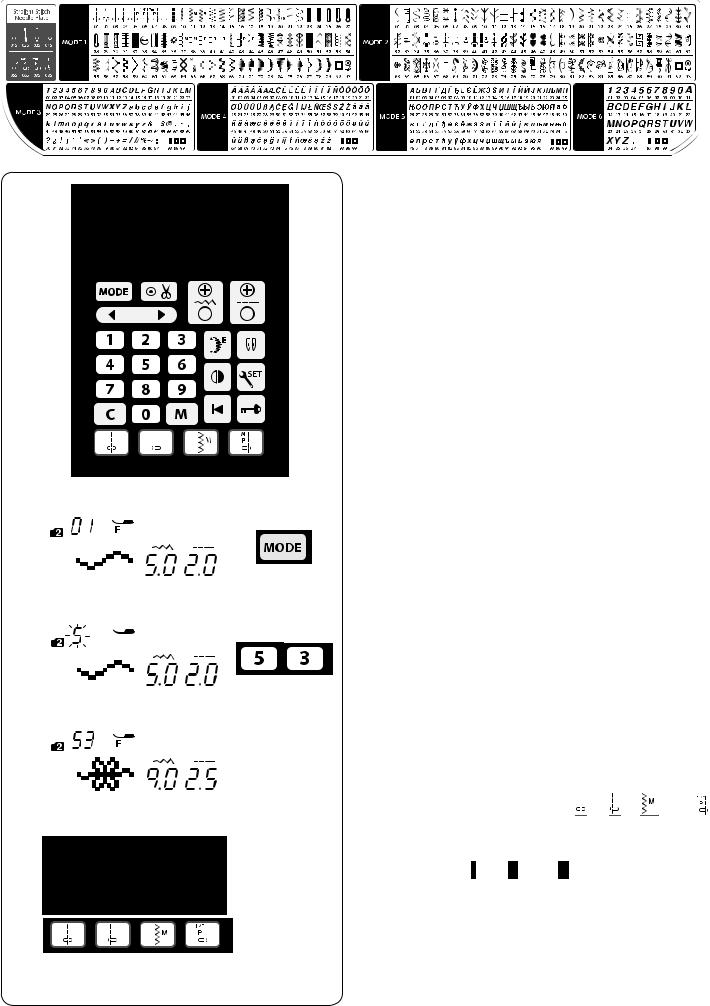
Selecting the Patterns
|
|
|
|
|
|
|
|
MODE 1–6 |
w |
|
|
|
|
To select stitch patterns in modes 1–6, first press the |
|||
|
|
|
||||||
|
|
|
|
|
|
|
|
MODE key q to select your desired mode. Each time |
|
|
|
|
|
|
|
|
you press the MODE key, the mode number w indicated |
|
|
|
|
|
|
|
|
on the left side of the screen will change, and the mode |
|
|
|
|
|
|
|
|
changes as follows, |
q |
|
|
|
|
|
MODE 1: Utility and decorative stitch pattern selection |
||
|
|
|
|
|||||
|
|
|
|
|
|
|
|
MODE 2: Decorative stitch pattern selection |
|
|
|
|
|
|
|
|
|
|
|
|
|
|
|
|
|
MODE 3: Number and letter selection |
|
|
|
|
|
|
|
|
MODE 4: European accented letter selection |
|
|
|
|
|
|
|||
|
|
|
|
|
|
|||
|
|
|
|
|
|
|
|
MODE 5: Cyrillic letter selection |
|
|
|
|
|
|
|||
|
|
|
|
|
|
|
|
MODE 6: 9 mm monogram selection |
|
|
|
NOTE: |
|
|
|
When the straight stitch needle plate is attached to |
|
|
e |
the machine, the patterns not suitable for the straight |
|
|
stitch needle plate cannot be selected. |
|
|
|
|
|
|
|
|
|
z |
|
Example: To select stitch pattern 53 in MODE 2 |
|
z Turn the power switch on. |
|
|
|
When the power switch is turned on, the utility and |
|
|
decorative stitch pattern selection (MODE 1) is set |
|
|
automatically. |
|
|
Press the MODE key once to select MODE 2. |
|
|
|
x |
|
x Press the number keys on the touch panel. First press |
|
||
|
|
key 5 and then press key 3. |
|
|
|
|
|
|
|
|
|
c Now pattern 53 in MODE 2 is selected. |
||||||||||||||||
c |
|
|
|
|
|
|
||||||||||||||||
|
|
|
|
|
|
|
Direct pattern selection |
|
|
|
|
|
|
|
|
|||||||
|
|
|
|
|
|
|
You can select the stitch patterns |
01 |
|
, |
04 |
|
, 11 |
|
and 06 |
|
||||||
|
|
|
|
|
|
|
directly by pressing the corresponding |
direct pattern |
||||||||||||||
|
|
|
|
|
|
|
selection keys e. |
|
|
|
|
|
|
|||||||||
|
|
|
|
|
|
|
|
|
|
|
|
|
|
|
||||||||
|
|
|
|
|
|
|
Stitch pattern |
01S |
, |
04S |
or |
06S |
can |
be also selected |
||||||||
|
|
|
|
|
|
|
when the straight stitch needle plate is |
attached to the |
||||||||||||||
|
|
|
|
|
|
|
machine (refer to page 16). |
|||||||||||||||
|
|
|
|
|
|
|
Press the direct pattern selection key r to select the |
|||||||||||||||
|
|
|
|
|
|
|
stitch pattern 01S. |
|||||||||||||||
|
|
|
|
|
|
|
Press the direct pattern selection key t to select the |
|||||||||||||||
|
r |
t |
y |
stitch pattern 04S. |
||||||||||||||||||
|
|
|
|
|
|
|
Press the direct pattern selection key y to select the |
|||||||||||||||
|
|
|
|
|
|
|
stitch pattern 06S. |
|||||||||||||||
24
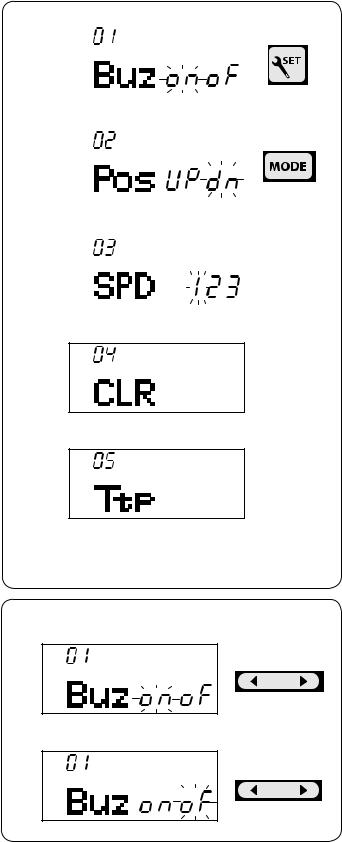
|
|
|
|
Customizing Machine Settings |
e |
|
q |
You can customize the machine settings to your |
|
|
||||
|
|
|
|
preference. |
|
|
|
|
|
|
|
|
|
Press the set key q and LCD screen will show the |
|
|
|
|
setting mode. |
|
|
|
|
Press the MODE key w to select the desired setting. |
|
|
|
|
|
|
|
|
|
In this mode, you can set the following machine functions. |
r |
|
w |
e Buzzer sound setting |
|
|
|
|
||
|
|
|
r Needle stop position setting |
|
|
|
|
|
|
|
|
|
|
t Start up speed setting |
|
|
|
|
|
|
|
|
|
y Resetting all to default |
|
|
|
|
u Key position calibration |
|
|
|
|
|
|
|
|
|
To exit the setting mode, press the set key q. |
t |
|
|
|
|
|
|
|
|
|
|
|
|
|
|
y
u
Buzzer sound setting
The buzzer sound can be turned on or off using the buzzer sound setting. The default buzzer sound setting is “ON”.
Enter the setting mode.
To turn off the buzzer sound, press the cursor key “  ” and the “oF” mark will blink.
” and the “oF” mark will blink.
To turn on the buzzer sound, press the cursor key “  ” and the “on” mark will blink.
” and the “on” mark will blink.
Press the set key to exit the machine setting mode.
25
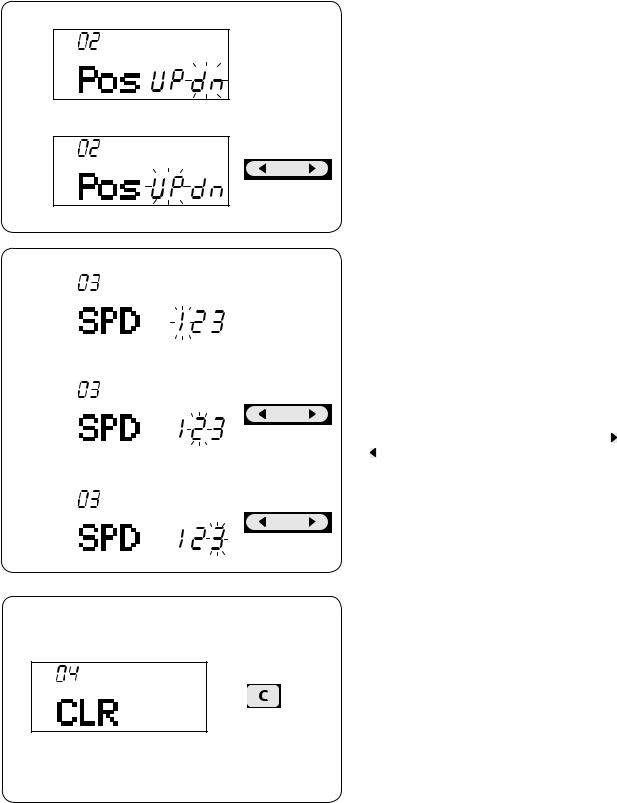
Needle stop position setting
The machine always stops with the needle in the down position except when sewing buttonholes, specialty stitches, monograms, etc. However you can select the needle stop position to up or down.
Enter the setting mode. Press the MODE key to enter the needle stop position setting.
The default needle stop position setting is down position “dn”.
To change the needle stop position, press the cursor key “  ” and the “UP” mark will blink.
” and the “UP” mark will blink.
Press the set key to exit the machine setting mode.
|
|
Start-up speed setting |
q |
|
The machine will start running slowly and the sewing |
|
||
|
|
speed will gradually increase to maximum when pressing |
|
|
the start/stop button. |
|
|
You can select the desired start-up speed from 1 (slow) q, |
|
|
2 (medium) w or 3 (high) e. |
w |
|
Enter the setting mode. Press the MODE key twice to |
|
||
|
|
enter the start-up speed setting. |
|
|
The default start-up speed setting is “1” (slow). To change |
|
|
the start-up speed, press the cursor key “ ” or |
|
|
“ ”, and the selected speed number will blink. |
|
|
|
e |
|
Press the set key to exit the machine setting mode. |
|
|
|
|
|
|
|
|
Resetting all to default |
|
|
The following customized settings can be reset to the |
|
|
original settings (factory settings). |
|
|
• Buzzer sound |
q |
• Needle stop position |
|
|
|
• Start up speed setting |
|
|
Enter the setting mode. Press the MODE key 3 times to |
|
|
enter the Resetting all to default mode. |
|
|
Press and hold the clear key q until the machine beeps |
|
|
to reset the machine to the factory default setting. |
|
|
Press the set key to exit the machine setting mode. |
26
